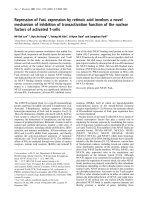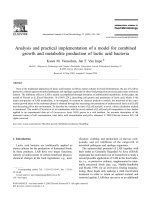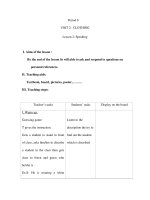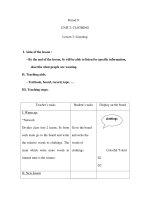fermentation of carrot juice by lactic acid bacteria
Bạn đang xem bản rút gọn của tài liệu. Xem và tải ngay bản đầy đủ của tài liệu tại đây (342.37 KB, 26 trang )
MINISTRY OF EDUCATION & TRAINING
CAN THO UNIVERSITY
BIOTECHNOLOGY RESEARCH & DEVELOPMENT INSTITUTE
SUMMARY
BACHELOR OF SCIENCE THESIS
THE ADVANCED PROGRAM IN BIOTECHNOLOGY
FERMENTATION OF CARROT JUICE
BY LACTIC ACID BACTERIA
SUPERVISOR
STUDENT
MSc. HUYNH XUAN PHONG
NGUYEN THI AI XUAN
Student code: 3082569
Session: 34 (2008- 2013)
Can Tho, 2013
APPROVAL
SUPPERVISOR
MSc. HUYNH XUAN PHONG
Can Tho, May
STUDENT
NGUYEN THI AI XUAN
, 2013
PRESIDENT OF EXAMINATION COMMITTEE
Abstract
This study was carried out in term to contribute for added
value of the available, inexpensive and high nutrition raw
materials as well as to diversify the production with good
characteristics. The study was divided into 2 stages. In the first
stage, isolation of the strain for fermentation was done from the
nature fermented carrot juice. Four isolates of lactic acid bacteria
were compared with other 6 strains from products of digested
powder (Luong Phuoc Truong, 2012). A strain of Lactobacillus
helveticus gave the best results (1.46% w/v). In the second stage,
the fermented carrot juice processing was tested with the selected
lactic acid bacteria. Of four testing media, carrot juice with 15%
(w/v) of saccharose and 30% dilution ratio was found as the best
medium. The favorable conditions for fermented carrot juice were
determined based on the results of sensory evaluation and
bacterial density determination and they were found as follow: at
5 log cell/mL of the bacterial inoculum, for 24 hours of
fermentation time and at 37ºC. The result of storage testing
showed that suitable temperature for product storage was 4-6ºC,
sensory evaluation (4.21) and bacterial density (7.13 log
CFU/mL) of final product maintained after 4 weeks.
Key words: carrot juice, lactic acid bacteria, Lactobacillus
helveticus, probiotic
i
CONTENTS
1. INTRODUCTION ............................................................... 1
2. MATERIALS AND METHODS.......................................... 3
2.1. Materials ....................................................................... 3
2.2. Methods ........................................................................ 3
3 RESULTS AND DISCUSSION ............................................ 7
3.1 Isolation of lactic acid bacteria ....................................... 7
3.2 Study on low pH tolerance of isolates ............................. 8
3.3 Study on lactic acid fermentation ability of isolates in
carrot juice ..........................................................................10
3.4 Identification of the selected lactic acid bacteria by
molecular technique ............................................................11
3.5 Study on the effect of dilution ratio and sugar content....12
3.6 Studying the effect of inoculums density, temperature
and time of lactic acid fermentation.....................................14
3.7 Study on temperature and time of storage ......................16
4. CONCLUSIONS AND SUGGESTIONS ............................18
REFERENCES .......................................................................19
ii
1. INTRODUCTION
Probiotication is one of the methods used to produce
fermented functional foods. Addition of probiotics to food
provides several health benefits including reduction in the level of
serum cholesterol, improvement of gastrointestinal function,
enhancement of immune system and reduction in risk of colon
cancer (Yoon et al., 2004).
Probiotic bacteria are increasingly used in food and
pharmaceutical applications to balance disturbed intestinal
microflora and related dysfunction of the human gastrointestinal
tract. Presently, the majority of products containing probiotics are
dairy-based, which include yogurt and fermented milk beverage.
However, due to some drawbacks related to dairy products, there
are emerging interests in using non-dairy ingredients as substrates
for delivering the physiological benefits of probiotics to wider
group of consumers (Mattila-Sandholm et al., 2002).
Non-dairy substrates that have been used for lactic acid
bacteria (LAB) fermentation include soy protein and cereals. In
recent years, several studies have reported the use of fruits and
vegetables juices as base medium for LAB fermentation. Juices
from these sources are deemed to be advantageous because of
their low allergenicity and perceived health benefits (Luckow and
Delahunty, 2004).
Carrots
are
good
source
of
carbohydrate,
calcium,
phosphorous, iron, potassium, magnesium, copper, manganese
and sulphur. It is an excellent source of vitamin A, B1, B2, C, E,
thiamin, folic acid and riboflavin. The intake of carrot as potent
antioxidants, appear to be associated with better health. It is not
1
only preventing vitamin A deficiency but also cancer and other
diet related human disease. (Beom et al., 1998).
Objectives:
To isolate and select lactic acid bacteria and to study the
favorable conditions of lactic acid fermented carrot juice with
biological values.
The content of this study includes:
- Isolation of lactic acid bacteria.
- Study on low pH tolerance of isolates.
- Study on lactic acid fermentation ability of isolates in carrot
juice.
- Identification of the selected lactic acid bacteria by
molecular technique.
- Study on the effect of dilution ratio and sugar content.
- Studying the effect of inoculums density, temperature and
time of lactic acid fermentation.
- Study temperature and time of storage.
2
2. MATERIALS AND METHODS
2.1. Materials
- Dalat and Chinese carrot were bought from Metro super
market.
- Six lactic acid bacteria were isolated from five probiotics
power and papaya juice fermentation (Luong Phuoc Truong,
2012)
- Culture medium: MRS (De Man Rogosa and Shape) agar
and broth.
- Chemicals: Yeast extract, peptone, glucose, manitol,
CaCO3, NaCl, NaOH 1N, H2SO4 1N.
- Devices:
+ Petri dish, pippetteman, eppendorf 1.5 mL
+ Incubator shaker Innova 4200, New Brunskick Scientific,
USA
+ Optical microscope Olympus DP12 BX41
+ Autoclave pbi international 22793
+ Refrigerator Sanaky Tokyo, Japan
+ Eppendorf centrifuge 5417R.
2.2. Methods
2.2.1. Isolation of lactic acid bacteria
Carrot juice solution was pasteurized. Then, it was incubated
for naturally fermented at 37ºC for 24-48 hours. After that, it was
cultured in MRS broth at 37ºC for 24 hours.
The bacterial suspension was streaked into MRS agar
medium, anaerobically incubated at 37ºC for 48 hours. Then,
typical colonies were subcultured several times until the purity of
culture was obtained.
3
Pure cultures were defined by observing cell morphology
under the optical microscope.
All pure bacterial isolates were characterized by Gram
staining, catalase, oxydase reaction and disintegration of CaCO3.
2.2.2. Study on low pH tolerance of isolates
Low pH tolerant ability of isolates was determined by isolate
density in growing media containing different level of pH. The
cultures were grown at 30ºC for 24 hours in MRS broth and were
used as an inoculum (5 log cell/ mL). Then, isolates were
inoculated in MRS broth medium with different pH levels (1,5;
2,5 and 3,5) in 2 hours (sterilized already at 121ºC for 15
minutes). Isolates were measured on plant count method at T0 and
T2 (afer 2 hours inoculation). The colonies were counted as viable
numbers of isolates in low pH
2.2.3 Study on lactic acid fermentation ability of isolates in
carrot juice
Carrot juice (pasteurized already with 140 mg/L of NaHSO3
in 20 minutes) was distributed in sterile tubes. The juice was
supplied with a inoculum with 5 log cell/mL isolates mixture
(each tube contained 36 mL carrot juice + 4 mL of inoculum).
Each tube represented a single sample and the experiments were
performed in triplication.
The lactic acid fermentation was performed in 37ºC for 48
hours. The microorganisms were counted on MRS plates.
Samples were taken at 48 hours intervals for chemical and
microbiological analysis. pH was measured with a pH meter.
Sugar content was measured by Brix handheld meter. Lactic acid
content expressed as percent lactic acid was determined by
4
titrating with 0.1N NaOH to pH 8.2. Viable cell counts (CFU/mL)
were determined by the standard plate method with MRS medium
after 48 hours incubation at 30ºC.
2.2.4 Identification of the selected lactic acid bacteria by
molecular technique
The bacterial isolate was identified by sequence analysis of
partial 16S rRNA gene. A couple of primer including forward
primer 8F: (5’-AGA GTT TGA TCC TGG CTC AG-3’) and
reverse primer 1492R: (5’-GGC TAC CTT GTT ACG ACT T-3’)
were employed to amplify the target gene through PCR
technique. DNA sequence of bacterial isolate was determined by
DNA machine. Nucleotide sequence was aligned and compared
with the data obtained from Gene Bank.
2.2.5 Study on the effect of dilution ratio and sugar content
The following variants differing with sugar levels: juice with
the addition of 6, 9, 12 and 15% sugar and variants differing with
dilution ratio 0, 10, 20 and 30% v/v.
Fermentation experiments were conducted in test tubes, each
containing 40 mL of pasteurized carrot juice. All samples were
inoculated with a 24 hours culture (5 log cell/mL) and incubated
at 37ºC for 48 hours.
The fermentation dynamics was analyzed on basis of the most
important physico-chemical (reducing sugar content, pH, lactic
acid
content)
and
microbiological
parameters
(numerical
evolution of the microbial inoculum) at 48 hours. In addition,
sensory evaluation of the fermented carrot juice show a
statistically significant effect of dilution ratio and sugar content
on its total quality
5
2.2.6 Studying the effect of initial inoculum density,
temperature and time of fermentation
The activity was designed with three factors: LAB density at
3
10 , 105 and 107 cells/mL; fermentation temperatures at: room
temperatures, 30ºC and 37ºC; fermentation time at: 24, 36 and 48
hours. Total number of treatments was 3 x 3 x 3 = 27 treatments.
The total number of experimental units was 27 treatments x 2
replicates = 54 units. Carrot juice was pasteurized by NaHSO3
140mg/L in 20 minutes and then transferred into tube. Inoculate
0.4 mL of bacterial suspension into tube containing 40 mL of
pasteurized carrot juice and incubated room temperatures, 30ºC
and 37ºC, respectively. Measure Brix level, pH, acid lactic
content and evaluated sensory after fermentation 24, 36, and 48
hours.
2.2.7 Study temperature and time of storage
From previous activities, selected the favorable conditions
including: isolate strains, inoculum density, sugar content (Brix),
dilution ratio, temperature and time of fermentation to produce
carrot juice at high quality. After fermentation, fermented carrot
juice tubes were stored at the different temperature conditions: at
room temperature (between 28ºC and 34ºC), in the cabinet cooler
(about 20ºC), in the refrigerator (4-6ºC) about 4 weeks of storage.
Found the better storage conditions.
2.2.8 Statistical data analysis
The statistical data were analyzed by Microsoft Office Excel
2003 and Statgraphics centurion XV (USA) software.
6
3 RESULTS AND DISCUSSION
3.1 Isolation of lactic acid bacteria
All pure isolates were classically defined by observing macro
and micro morphology. As the result, 4 isolates of lactic acid
bacteria were isolated from 2 kinds of carrot (Dalat and Chinese).
Colonies of all isolates were round, smooth, grayish white.
Because of the differentiation of collected samples, the cell
morphology was various as shown in Table 6’.
Moreover, 4 isolates were characterized in Gram positive,
lack of calatase and oxydase, produced clear zone around
colonies in medium containing CaCO3. The result of Gram
staining of 2 representative isolates is described in Figure 14.
Figure 14. Gram staining of isolates
Two lactic acid bacteria were isolated from Dalat carrot.
DL52 were defined as V rod-shaped whereas DLII3 looked like
rod-shaped. The isolates TQ13 and TQ25 from Chinese carrot
were rod-shaped.
Four isolates were characterized of basically characteristics of
lactic acid bacteria, they had varieties of both morphology and
isolated samples.
7
Table 6’. Cell morphology of isolates
The
Numbers
Sample
1*
Antibio probiotic powder
A
Short rod
2*
Probio probiotic powder
Pro
Short rod
3*
Ybio probiotic powder
Y
Short rod
4*
Lactomin plus probiotic powder
Lac
Cocci in short chains
5*
Biosubtyl probiotic powder
Bio
Long rod
6*
Papaya juice
DD
Pairing rod
7
Carrot juice
DLII3
Cocci in pairs
8
Carrot juice
DL52
rod in V-shaped
9
Carrot juice
TQ13
Short rod
10
Carrot juice
TQ25
Short rod
isolate
Cell morphology
Note: The isolates were marked * from Phuoc Luong Truong (2012)
3.2 Study on low pH tolerance of isolates
Guarner and Schaafsma (1998), Schrezenmier and de Vrese
(2001) reported that a probiotic properties is the ability to survive
gastrointestinal transit.
Low pH tolerance of isolates was determined by monitoring
the density of LAB cells after 2 hours inoculated to MRS broth
medium at different pH: 1.5; 2.5; 3.5. The results of counting
plate density of isolates cells were showed in Table 7.
8
Table 7. Density of isolates in MRS broth at low pH
pH
1,5
2,5
3,5
The isolate
A
Pro
Lac
Bio
Y
DD
DLII3
DL52
TQ13
TQ25
A
Pro
Lac
Bio
Y
DD
DLII3
DL52
TQ13
TQ25
A
Pro
Lac
Bio
Y
DD
DLII3
DL52
TQ13
TQ25
LogT0
(log CFU/mL)
1.61gki
1.51lm
1.45mm
1.59jklm
1.69gki
1.53lm
1.59jklm
1.53lm
1.56klm
1.89fgh
2.14de
2.21d
2.01ef
2.0efg
2.14def
1.9fgh
1.85ghi
1.8hi
1.74hij
1.81hi
4.42bc
4.58a
4.47ab
4.53ab
4.55ab
4.57ab
4.53ab
4.51ab
4.42c
4.26c
LogT2
(log CFU/mL)
6.82d
6.82cd
6.82cd
6.81d
6.83cd
6.82cd
6.87abcd
6.81d
6.81d
6.85abcd
6.84bcd
6.88abc
6.84bcd
6.83cd
6.84bcd
6.86abcd
6.83bcd
6.85bcd
6.83cd
6.85bcd
6.89ab
6.92a
6.83cd
6.86abcd
6.85bcd
6.85bcd
6.86abcd
6.81d
6.89ab
6.82cd
* Note: Value in the table was average value of triplications. Difference
value of statistics only had meaning in the column; the average values with the
same letter were not significant at 95% probability.
The density of isolates was used to evaluate the development
and survival of isolate cells. Initial cell density was about 4.219
4.46 log CFU/mL. When supplied into the pH 1.5 and 2.5
medium, these 10 isolates could grow and survive after 2 hours
incubation at 37ºC temperature. In pH 3.5 medium, isolates grew
well, reaching density of about 6.55 to 6.99 log CFU/mL. In low
pH supplied media, density of isolates decreased correlatively
with the decrease of pH level.
3.3 Study on lactic acid fermentation ability of isolates in
carrot juice
Table 8. Following indicators fermented carrot juice
The
Isolates
A
Pro
Lac
Bio
Y
DD
DLII3
DL52
TQ13
TQ25
ºBrix
5.00c
6.83a
5.67bc
6.33ab
6.67a
6.83a
6.83a
6.50a
7.00a
5.67bc
pH
Acid
(% w/v)
3.62b
3.23c
4.08a
3.66b
3.21c
4.18a
3.74b
4.17a
4.18a
3.99a
1.31b
1.46a
0.54e
0.81c
1.39ab
0.46f
0.83c
0.67d
0.51ef
0.71d
Log T0
(log
CFU/mL)
5.16ab
5.17ab
5.16ab
5.19ab
5.15bb
5.16ab
5.17ab
5.18ab
5.21a
5.18ab
Log T48
(log
CFU/mL)
8.67bc
8.69a
8.33ef
8.43de
8.85ab
8.02g
8.54cd
8.33ef
8.16fg
8.37de
* Note: Value in the table was average value of triplications. Difference
value of statistics only had meaning in the column; the average values with the
same letter were not significant at 95% probability.
The results in Table 8 showed that pH after fermentation was
lower than initial, roughly 3.21 to 4.18. During fermentation
process, isolates converted glucose into lactic acid, reduced the
pH of the fermenting liquid. Similarly, Brix levels also decreased
after fermentation.
One of the basic requirements demanded from probiotic
products is a proper number of probiotic bacteria at the level of at
least 6 log CFU/mL. The survival rate of all isolates at the level
10
of about 8.02-8.69 log CFU/mL of fermented carrot juice.
Addition, the result of lactic acid concentration measured of
different level, ranging 0.46-1.46% w/v. The highest lactic acid
concentration was Pro with 1.46% w/v. Therefore, this isolates
were chosen for next activities.
3.4 Identification of the selected lactic acid bacteria by
molecular technique
Isolate Pro was selected to sequence 16S rRNA gene and
BLAST on NCBI website (). The
result showed that the gene sequences of isolate Pro shared 99%
similarity with Lactobacillus helveticus.
Result of BLAST on NCBI of isolate Pro
Lactobacillus
helveticus
is
an
important
industrial
thermophilic starter that is predominantly employed in the
fermentation of milk for the manufacture of several cheeses. In
addition to its technological importance, a growing body of
scientific evidence shows that strains belonging to the Lb.
helveticus species have health-promoting properties. Several in
vitro studies showed that Lb. helveticus possesses many common
probiotic properties, such as the ability to survive gastrointestinal
transit, adhere to epithelial cells, and antagonize pathogens
(Valentina and Simone , 2012).
11
3.5 Study on the effect of dilution ratio and sugar content
The results of Lb. helveticus density and lactic acid content of
carrot juice fermentation were presented in Furgre 17’.
Lactic acid content (%w/v)
1.40
6%
1.20
9%
1.00
12%
15%
0.80
0.60
0.40
0.20
0.00
0
10
20
30
Bacterial density (LogCFU/ml)
Dilution ratio (% v/v)
9.8
6%
9.6
9%
12%
9.4
15%
9.2
9
8.8
8.6
0
10
20
30
Dilution ratio (%v/v)
Furgre 17’. Changes of lactic acid content
and Lb. helveticus density
In the same dilution ratio carrot juice. Figure 17’ compared
the lactic acid generated by Lb. helveticus at 6, 9, 12, and 15%
sugar. Lb. helveticus was able to ferment well at 15% glucose
(1.17% w/v). However, they did not have the same results at ratio
12
dilution 0%. Perhaps high glucose concentrations caused a certain
inhibition on bacterial activities.
Lactic acid content after fermentation was statistically
significant difference at four dilution ratio. Figure 17’ presented
the highest lactic acid content was at 20-30% of dilution ratio. On
the other hand, a density of bacteria in all dilution ratios was
greater than 6 (log CFU/mL).
Table 10. Results sensory evaluation carrot juice
fermented by dilution ratio and sugar content
Dilution ratio
(%v/v)
0
10
20
30
Sugar
content(%w/v)
6
9
12
15
6
9
12
15
6
9
12
15
6
9
12
15
Sensory scores
2.60cd
2.65cd
2.7bcd
2.75bcd
1.60d
2.65cd
3.08bc
2.77bcd
2.75bcd
3.42abc
3.87abc
4.10ab
2.75bcd
2.75bcd
3.25abc
4.55a
* Note: Value in the table was average value of triplications. Difference
value of statistics only had meaning in the column; the average values with the
same letter were not significant at 95% probability.
The results showed that fermented juice samples at initial
dilutions were statistically significant different (p<0.05). Table 10
presented the highest sensory evaluation was 4.55 at 15% glucose
and 30% of initial dilution. It was significantly different from 010% of initial dilution but not from 20% water, because smell of
13
20% dilution ratio was quite sour. In summary, sugar content
15% and 30% dilution ratio were favorable conditions to lactic
acid fermentation
3.6 Studying the effect of inoculums density, temperature and
time of lactic acid fermentation
This activity was set up with 3 levels (30, 28-34, and 37ºC)
for temperature factor, 3 levels (3, 5, and 7 log cells/mL) for
inoculum density factor, and 3 levels (24, 36, and 48 hours) for
time factor.
Figure 19, 20 indicated that lactic acid content in samples of
24 hours incubation was lower than those of 48 hours and 36
hours incubation, with the same inoculum density and
temperature. Addition, at the same temperature and fermentation
time, inoculum density of 7 log cells/mL gave higher lactic acid
Lactic acid content (%w/v)
content than inoculum of 3 and 5 log cells/mL.
1.6
1.4
1.2
1
0.8
0.6
0.4
0.2
0
24 hour
36 hour
48 hour
30˚C
28-34˚C
37˚C
3
5 7
3 5 7
3
Inoculum density (log CFU/mL)
5
7
Figure 19. Changes of lactic acid content
by inoculums density, temperature and time
of lactic acid fermentation
14
Bacterial density (log CFU/mL)
10
30˚C
24 hour
36 hour
48 hour
9.5
28-34˚C
37˚C
9
8.5
8
7.5
7
3
5
7
3
5
7
3
5
7
Inoculum density (log CFU/mL)
Figure 20. Changes of Lb. helveticus density
by inoculums density, temperature and time
of lactic acid fermentation
Besides, with the same inoculum and incubation time, lactic
acid content and Lb. helveticus density at 37ºC was higher than
that at 30ºC and 28-32ºC, showing that 37ºC was optimal
temperature for the growth and development of bacteria. This
could lead to high lactic acid was converted.
Bacterial density required in probiotic products to be equal or
more than 6 log cells/mL. All the samples with more than 6 log
cells/mL after 24 hours incubation were considered potential
probiotic products.
Shortly, quality probiotic products could be qualified if
fermentation using minimal inoculum density of 3 log cells/mL at
30-37ºC, and incubation time of 24, 36, 48 hours.
15
Evaluation sensory (scores)
5
4.5
4
3.5
3
2.5
2
1.5
1
0.5
0
24 hour
36 hour
48 hour
30˚C
28-34˚C
37˚C
3
5
7
3
5 7
3
Inoculum density (log CFU/mL)
5
7
Figure 21. Evaluation sensory of inoculums density,
temperature and time of lactic acid fermentation
Figure 21 indicated that the sample had the highest score (4.5)
with initial inoculum density of 5 log cells/mL, incubation time at
37ºC in 24 hours. Because the smell was gentle and the taste was
favorable sweet-sour. In contrast, the sample had the lowest score
with initial inoculum density of 3 log cells/mL, incubation time at
37ºC in 48 hours.
In summary, optimal conditions for fermentation of carrot
juice were inoculum density of 5 log cells/mL after 24-hours
incubation at 37ºC.
3.7 Study on temperature and time of storage
Table 12. Results of temperature and storage time product
time of
storage
(week)
0
1
Temperature
of
storage(ºC)
4-6ºC
20-25ºC
pH
3.87a
3.81b
3.69c
Acid
content
(%w/v)
0.96g
1.04ef
1.29d
16
Density
(log
CFU/mL)
8.72a
8.74a
6.94d
Sensory
score
4.37ab
3.46e
2
3
4
28-32ºC
4-6ºC
20-25ºC
28-32ºC
4-6ºC
20-25ºC
28-32ºC
4-6ºC
20-25ºC
28-32ºC
3.56d
3.61d
3.49e
3.36f
3.36f
3.28g
3.14h
3.09hi
3.04i
2.87i
1.54bc
1.33e
1.5bc
1.62a
1.30d
1.60a
1.61a
1.41c
1.63a
1.55ab
5.18g
8.05b
5.73e
5.02h
7.24c
5.42f
4.53i
7.13c
4.38j
4.37j
2.19i
4.40a
3.07f
1.65j
4.21b
2.81g
1.27k
4.21b
2.45h
0.94l
* Note: Value in the table was average value of triplications. Difference value of
statistics only had meaning in the column; the average values with the same letter were
not significant at 95% probability.
At 20-25ºC and 28-34ºC were suitable ranges for bacteria to
grow and develop. After using all soluble sugar and nutrients as
well as increasing lactic acid content, the bacteria started to be
inhibited and died, so Lb. helveticus density was low than 6 log
cells/mL in the second week.
On the other hand, Lb. helveticus density was still higher than
6 log cells/mL after 4 weeks of storage at 4-6ºC. There were
significant differences in sensory after 4 weeks of storage at 46ºC. After 4 weeks of storage, fermented carrot juice did not
change the value of taste and color, while others had negative
sour taste. Therefore, temperature 4-6ºC in four week was
recommended to store fermented carrot juice.
17
4. CONCLUSIONS AND SUGGESTIONS
4.1 Conclusions
Molecular analysis showed that Pro belonged to Lb.
helverticus. It gave the best results (1.46% w/v acid content )
30% (w/v) of dilution ratio and 15% (w/v) of sugar content
conditions applied for the fermentation.
The appropriate environmental conditions for bacterial
development were to incubate at 37ºC for 24 hours with initial
cell densities of 5 log CFU/mL
A range of storage temperature (4-6ºC) ensured product
qualities, and maintained bacterial populations for 4 weeks.
4.2 Suggestion
Because of scope and limitation of graduate thesis, the project
just achieved some research findings. Consequently, this project
was able to develop; several further researches can be
implemented.
- Studying the proper storage conditions and maximum storage
time.
18
REFERENCES
Vietnamese
Lương Phước Trường. 2012. Phân lập và tuyển chọn vi khuẩn
acid lactic trong sản xuất nước đu đủ lên men. Luận văn
nghành Công nghệ Sinh học, Viện Nghiên cứu và Phát
triển Công nghệ Sinh học- Đại học Cần Thơ.
Nguyễn Thị Hiền. 2006. Công nghệ sản xuất mì chính và các sản
phẩm lên men cổ truyền. Nxb Khoa học và Kỹ thuật, trang
209-211.
English
Beom, J., S. Yong and H. Myung, 1998. Antioxidant activity of
vegetables and blends in iron catalyzed model system. J.
Food Sci. and Nutr., 3: 309-314.
Guarner F. and G.J Schaafsma, 1998. Probiotics. International
Journal of Food Microbiology 39, 237-238.
Luckow, T. and C. Delahunty. 2004. Which juice is healthier? A
consumer study of probiotic non-dairy juice drinks. Food Qual.
Prefer.
Marteau P., de Vrese M., Cellier C.J., and Schrezenmier J., 2001.
Protection from gasterointestinal deseases with the use of
probiotics. Am J Clin Nutr
Mattila-Sandholm, T., P.Myllarinen, R. Crittenden, G. Mogensen,
R. Fonden and M.Saarela. 2002. Technological challenges
for future probiotic foods. Int. Dairy J. 3:173-182.
Yoon K.Y., Woodams E. E. and Hang Y.D. 2004. Probiotication
of tomato juice by lactic acid bacteria. J. Microbiol. 42(4):
315-318.
19









